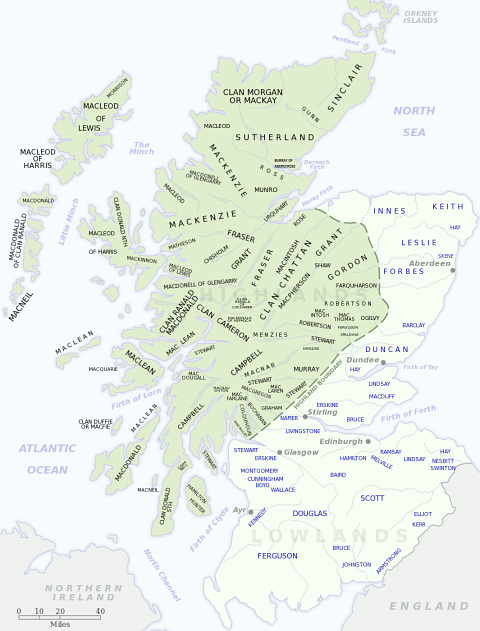
Motto: Fortitudine
Historic Seat: Eilean Donan Castle
District: Ross, Sutherland
Associated Surnames: Macara, MacCrae, MacCraw, MacCreath, MacGrath, Macra, MacRach, MacRaith, MacRath, Raith
Associated Tartans:
Early MacRae Genealogy and History:
(Excerpt from "The Scottish Clans and Their Tartans", James Grant, 1906)
The natives of the parish of Kintail, says the author of the "Old Statistical Account," writing in 1793, "are all MacRaes, except two or three families."
When the MacRaes first entered Kintail, there were several clans inhabiting the district, particularly the MacAulays, of whom no vestige now remains.
A William Rae, or MacRae, was Bishop of Glasgow in 1335.
In the second line at the battle of Killiecrankie1 were the MacKenzies of Seaforth, with the MacRaes from Kintail. On this day the latter were led by Duncan Mòr of Torluish. Under him the MacRaes were said to have made a desperate resistance, and to have died almost to a man. Ere he fell, he was frequently seen to brandish his claymore on high, and heard to shout, "Cobhair! cobhair! an ainn Dhia's an Righ Sheumais!" ("Relief! Relief! in the name of God and King James!") A recent writer in the "Inverness Courier" states that ere Duncan was slain he slew fifteen with his own hand, which was so swollen in his claymore hilt that it was extricated with difficulty.
In 1778 Edinburgh was startled by what was known as the "Affair of the Wild MacRaes," some hundreds of whom had enrolled in the Seaforth Regiment of Highlanders, formed in 1778 by Kenneth, the Earl of that title, and which mutinied at Edinburgh on hearing that they had been sold to the East India Company. In military order, after one wing had fired on another at Leith Links, the main body marched to Arthur Seat, where they threw up trenches, which are visible to this day under the cone of the hill near the loch of Dunsappie, and defied all attempts to reduce them, even though the 11th Light Dragoons, 200 of the Buccleuch Fencibles, and 400 of the Glasgow regiment environed their position.
General Skene, Lord MacDonald, and others proved to the men that their complaints were groundless, and the affair, which promised to have a serious termination, was satisfactorily arranged by the Duke of Bucchleuch. The regiment then marched with pipes playing to Holyrood, and on the 27th September embarked for Guernsey, from whence it soon after sailed for India on what proved a fatal voyage to the MacKenzies and MacRaes, for ere St. Helena was in sight Lord Seaforth died, and then a great grief, with the mal du pays,2 fell upon his clansmen; so of the thousand who sailed from the British Isles, 230 perished at sea, and only 390 were able to carry arms when, in April 1782, they began the long, hot, and toilsome march to Chingleput.
There were several bards of old in Kintail. One of the last of these, John MacRae, otherwise MacChurchi, emigrated to America before the close of the last century, where he met with many misfortunes.
At the first siege of Bhurtpore in 1805, one of the clan, Colonel MacRae, led the stormers under a fire so dreadful that of them alone no less than 591 fell.
(End excerpt)
Next page: Clan Malcolm
Footnotes:
1 The Battle of Killiecrankie (1689): The Battle of Killiecrankie was fought on 27 July 1689 near Killiecrankie, in Perthshire, Scotland. It took place during the First Jacobite Rising between a Jacobite force of Scots and Irish, and those of the newly arrived William of Orange's Scottish government forces. Read more about the Battle of Killiecrankie at Wikipedia.
2 mal du pays: homesickness

Distribution of Scottish clans and families
View larger map at Wikimedia Commons

Browse the Clan MacRae Tartan Collection with home decor, personal accessories, crafting, paper products, and more.

Clan MacRae Postcard: Digitally cleaned and enhanced vintage illustration with tartan frame.